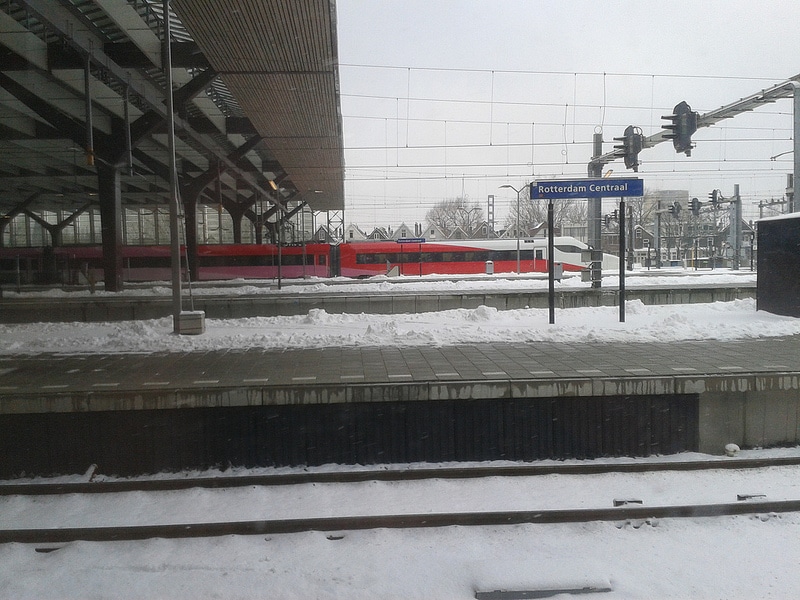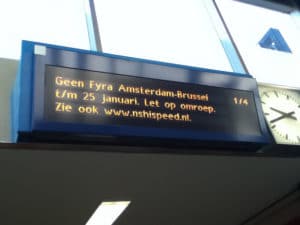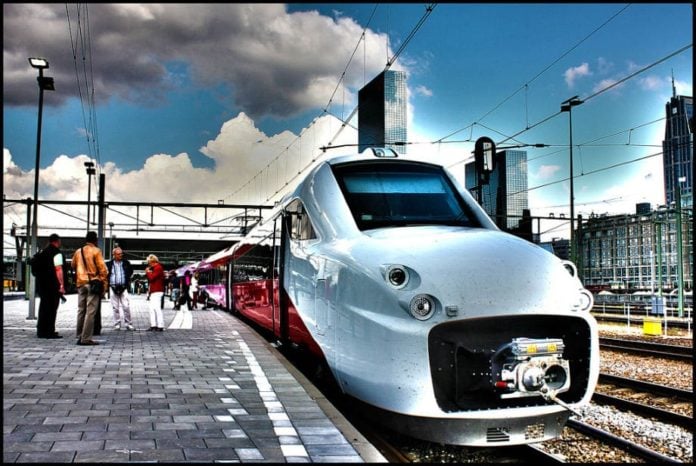The last couple of months have brought us headlines about a high speed rail debacle over in The Netherlands and Belgium. The relatively new high speed rail service that connects these two countries, named Fyra, has been permanently suspended after a series of safety issues that plagued the service ever since it began its operations in 2009. But before we get into that, let’s take a look at the troubled history of Europe’s youngest high speed rail service.
Four – not ‘Fier’
Fyra is Swedish for four, and symbolizes the four cities that the service sought to connect: Amsterdam, Rotterdam, Antwerp and Brussels. €7 billion has been spent on the Dutch portion of the route, yielding a straight route between Amsterdam Airport and the Dutch-Belgian border, at parts sitting on concrete stilts and hovering above the flat Dutch landscape; at parts sunken into a trench so as to minimize the intrusion of the route (and noise from the train traffic) in urban areas. The route was also designed to allow trains to travel at speeds of up to 300 kilometers per hour. The Dutch state picked up the tab of the construction of the new tracks, which were also constructed to service the Thalys high speed rail service to Paris, in addition to the envisioned Fyra service to Brussels.

The Dutch High Speed Alliance or HSA (a joint venture between Royal Dutch Airlines and Dutch Railways) began to operate (or exploit) the Dutch portion of the route between Amsterdam and the Dutch border in 2009, years after the line was originally scheduled to be completed. (Service on the full route between Amsterdam and Brussels was to follow much later). To operate the high speed rail service on the Dutch portion of the route, the HSA would pay the Dutch government €148 million per year. What is more, the HSA, in which Dutch Railways has a 90% stake, originally offered to pay €178 million per year for the right to operate the route—more than twice the amount offered for the rights by foreign bidders. HSA offered this unjustifiably high amount out of fear that a foreign carrier would soon be providing train service in the Netherlands—a doom scenario that the monopolists at Dutch Railways had to avoid, at any cost.
The Italian Job
The exceptionally high payment put HSA on the verge of bankruptcy. Indeed, the operator’s dire financial situation was to be the main reason why the decision was made to economize on the “rolling equipment”, or the trains that would service the route. In order to reduce the operational costs, HSA and the National Society for Belgian Railways opted to use cheaper and slower trains than typically seen on other European high speed rail routes. The Italian manufacturer AnsaldoBreda (an inexperienced newcomer to the industry) won the contract to supply the trains for the new service. After requesting qualifications from a host of train builders, AnsaldoBreda was eventually selected because of their competitive pricing. The price per seat of their trains was about half that of Siemens’ ICE trains, or Alstom’s TGV trains.
Looking back on AnsaldoBreda’s contracting, Dutch daily NRC Handelsblad reported in January that the HSA never had the intention to operate a “true” high speed rail service; a strong piece of investigative journalism stated that a speed of 220 kilometers per hour had been deemed sufficient for the Dutch portion of the route from the git-go by the HSA executives (by comparison, high speed rail service in Germany and France exceeds 300 kilometers per hour). Looking ahead to the opening of the full route between Amsterdam and Brussels, it became clear that the preferred model (AnsaldoBreda’s V220 trains) would not be able to reduce the travel time between these two cities as much as the operators had promised. Hence why a slightly faster model, AnsaldoBreda’s V250, was eventually selected to service the route—but only after the Dutch government pointed out that HSA had a contractual obligation to reduce the travel time by a certain margin, which the V220 model would not meet. And so, in 2004, the HSA placed an order for 19 V250 train sets with the Italian manufacturer.
The equipment was supposed to be delivered to the Dutch in 2007, but the inexperienced manufacturer failed to do so. When the equipment was finally delivered to The Netherlands in September of 2009, train service between Rotterdam and Amsterdam’s central stations could commence, over two years after the envisioned date. Starting with one train per hour on weekdays, service gradually expanded to weekends and holidays. By April 2011 service had increased to one train per 30 minutes, and the route had been extended to run between Amsterdam and the southern Dutch town of Breda. Finally then, on December 9th 2012, the full route between Amsterdam and Brussels was serviced. Right from that day, the service was plagued by a myriad of technical issues.
Getting the Fyra running
In the first week, many runs between the two cities were cancelled; the ones that were not often incurred significant delays. It is estimated that half of all passengers in this first week of international service did not arrive on their destinations on time; two-thirds dealt with a delay of 15 minutes or more, and about 20% of passengers faced delays exceeding 30 minutes. Dutch Railways (and their Belgian counterparts) were flooded with complaints from passengers. The technical issues persisted, and even intensified over the course of the next month. On January 15th, half of all trains were cancelled due to broken equipment, whilst the other half of scheduled trains ran with an average delay of one hour. Due to wintry weather, 85% of all scheduled trains were cancelled two days later on January 17th. It is perhaps no surprise that during the first month of Fyra service, local trains servicing the route saw a huge increase in popularity, despite their comparatively low speed. What the local trains lacked in terms of travel time, however, they made up for in their solid reliability and in their pricing.
Facing security concerns and strong criticism from passengers and politicians alike, the Fyra was suspended indefinitely on January 18th—a little over a month since it first began servicing the originally envisioned route between Amsterdam and Brussels. Dutch Railways held manufacturer AnsaldoBreda responsible for the technical issues; AnsaldoBreda maintained that the issues were minor and would be resolved in a matter of days. However, a day later on January 19th it was announced that the technical issues with AnsaldoBreda’s V250 trains were not going to be addressed any time soon. At this point, 9 trains had already been delivered and the HSA had already paid €100 million euro to AnsaldoBreda, whilst the National Society for Belgian Railways had paid €35 million, ensuring that a lengthy legal battle between the manufacturer and the operators is ahead.
After some contemplation, the National Society for Belgian Railways dissolved their contract with AnsaldoBreda. On May 31st, the company’s CEO presented an impressive list of technical issues that engineering firms Mott McDonald and Concept Risk found with AnsaldoBreda’s V250 trains:
- Large-scale problems with the infiltration of water in the trains;
- Erosion and rustiness around the trains’ axels’, with rust appearing on one particular axis after just a few kilometers had been travelled;
- Poor fitting of the hydraulic and electrical cables onto the trains (these were placed on the bottom of the train, allowing it to incur damage due to the weight of the trains)
- Technical differences between the various train sets, since the mechanics had each manufactured the train sets in their own ways;
- Problems with the braking system, which was designed for speeds of up to 160 kilometers per hour, and not approved for use at speeds of up to 250 kilometers per hours (moreover, the wintry circumstances required an even lower speed, since the brake path was longer in wintry conditions)
- The batteries, which are located under the passenger cabs, could ignite. There have been images of damage that occurred after a battery caught fire near the Dutch town of Watergraafsmeer. One image shows a burnt carpet on the floor of a passenger cab.

At the same time, manufacturer AnsaldoBreda continued to reject the CEO’s criticism, and threatened to sue the National Society for Belgian Railways for dissolving the contract. Days later, on June 3rd, Dutch Railways announced that it too would stop operating the V250 trains. With that decision, the Fyra service had come to a premature end just months after the service commenced. Since then, the ads for the service have been removed and investigations into the contracting of AnsaldoBreda are on their way on both sides of the border.

If all this sounds like a waste of money to you, keep in mind that the conventional intercity train service between Amsterdam and Brussels, the Beneluxtrain, first had to be cancelled in order to make the operation of the new high speed service economically feasible. The Beneluxtrain was very popular with travelers, and even though they needed up to an additional 90 minutes to span the distance between Amsterdam and Brussels, the relatively low price made it an attractive option. Since the Fyra was not very likely to compete against conventional trains servicing the route, the Beneluxtrain had to be discontinued in order to force customers to travel on the Fyra. This has led to a lot of protests even before the Fyra began its operations. In a free market, where the Beneluxtrain had been allowed to continue its operations, the Fyra probably wouldn’t have had quite the clientele it had when it first began its operations. This is likely why the monopoly needed to be secured before the Fyra could start its service.
Days after the announcement that the operations of the V250 trains would stop, Dutch Railways had gotten until October 1st from Wilma Mansveld (the Dutch Secretary for Infrastructure) to present plans for an alternative service on the route. Mansveld also stated that Dutch Railways would retain the right to operate service along the route, remarkable as that might be. And so, last week Dutch Railways had placed an order with Canadian manufacturer Bombardier for an unknown number of TRAXX locomotives. Even though Dutch Railways declines to comment on how many locomotives it has ordered, their intention is to resume train service along the new route between Amsterdam and Brussels using these locomotives, which can reach speeds of up to 160 km/h. Before the Fyra service began in December, Dutch Railway was also using these locomotives to operate conventional intercity train service along the newly built tracks. The locomotives that were used to operate the route back then are currently being used elsewhere, which is why additional locomotives needed to be ordered. Until these are ready to begin servicing (portions of) the route, other options are being expanded. Conventional intercity trains between The Hague and Brussels will run with an increased frequency, and the number of Thalys trains that run between Amsterdam and Brussels increased from 9 to 11.
Fyra: What now?
This story is far from finished and it remains to be seen what consequences the manufacturer and the operators might face once the investigations have wrapped up. And whilst we don’t know much about the future of high speed rail in the Low Countries, we can already conclude that the story of the Fyra service is a textbook example of how not to plan and build a high speed rail system. It also is a poor use of the taxpayers’ euros, especially because the Dutch state had massively invested in a new, direct train route that it had partially built for the Fyra service to Brussels (as stated, the route is also used for the Thalys service to Paris, so the investment thankfully hasn’t been in vain). The Fyra-story also demonstrates that powerful corporate interests (in this case Dutch Railways’ desire to remain the sole rail service provider in The Netherlands) can abuse their position and waste an unbelievable amount of taxpayers’ money. It’s easy to imagine that, if a foreign provider would have been selected, they would have ended up paying the Dutch state less fees to operate train service along the route– leaving more funds available to properly invest in the rolling equipment. (It’s also unlikely that a foreign operator, paying lower fees to for the rights to use the route, would have needed the financial aid that the HSA needed from the state to avoid going bankrupt.) What is more, the high speed rail service would probably not have been feasible if its competitor, the Beneluxtrain, had not been discontinued.
Finally, it also shows that, if you are planning on introducing high speed rail to a country or region, you probably don’t want to do so as half-heartedly (or should I say, “as cheap”) as the Dutch and the Belgians did it. Unless serious funds are going to be committed to bring high speed rail to a region, chances are, it will turn into a giant fiasco à la Fyra. (You get what you pay for.)

The article you write did help me understand this a bit better, so thanks for that. However, while the text itself is balanced, the pictures and more notably the captions about Italians are unfair. Yes indeed the train manufacturers screwed up, but that doesn’t mean we should be bashing the whole nation.
Good point, and it’s a pity for the Italians as an industrial nation, since often they also produce high-end products (just not with the Fyra, I was responsible for some of these captions btw, scusa mi). And of course, the real blame for the debacle is to be put with the railroad-companies and governmental bodies.
Thanks for removing the pics and the captions!
God, Ronald, are you biased…
Basically you write about some major problem because Dutch Railways acted too proud to avoid letting a foreigner provide services in NL; proceeded to plan VERY poorly and choose the lesser supplier. I dont question about the problems of that company and its service, but to sprinkle the article with such idiotic captions is imature at best and a glimpse of the very dutch mentality that led to the Dutch Railways putting national pride ahead of its operational obligations.
No way, this had nothing to do with pride, rather the opposite. Cooperate arrogance and the ignorance of the CEO let to this. And I personally believe that taking such high risks on costs of the Dutch people who in the end had to pay the bill, is “anti-national” behaviour.
Is it not biased to contribute the acts of 1 party to a whole country? (“very dutch mentality”)
I am sure there was more to it than to avoid a foreign service…especially if they could make money of it or it would have improved our/the inftastructure drastically.
The captions indeed were also poorly planned and chosen.
AnsaldoBreda also have problems in Denmark (IC4), and Norway with some street cars in Oslo.
Every time I see the AnsaldoBreda name I just sit back an wait for things to blow up.
On the other hand, they built high-speed trains which are running perfectly fine in Italy. But it always goes wrong when they build something for northern Europe.
Great article, it sums it all! Small observation though: the HSR track is not much waste of taxpayer money in itself, since every HSR in Europe is (and can only be, except in UK where they found out how wrong it is not to have it done by the State and the Treasury had to chip in twice the amount to get it back on track!) subsidized to exist and improve the overall infrastructure of the continent, which is only economically beneficial on the long term. that is not the issue at stake here, but the fact that NS got the concession without anyone even questioning or flagging that they will not be able to deliver, and this could have already been figured out in the bid only by the fact that they offered twice as much as any other bidder (a hint?? hello!!!), is the responsibility of the Authorities (probably also keen on giving this to NS for political reasons), authorities which may soon put tax payers money at stake to salvage the project. Next time: buy German or French!
And the worst is the intercity train, which was giving a much better service: much better price and specially having the flexibility to travel in any train without having to book a seat in advance was a huge deal!
I am sure you could have this kind of flexibility travel with Fyra, but probably having to pay a even more expensive rate.
If I have to pay 40% less and be 90 mins more, in most case I’d rather have that
[…] not only have we entertained ourselves the past couple of years with some trafficjams and high-speed train projects seriously gone wrong. The Dutch are now truly rocking the traffic and smart cities scene with […]
I would not say Ansaldo Breda is inexperienced. The whole Italian high we network runs on their trains and works pretty well!
[…] your way through the Dutch train stations, more ranting about slow and full trains or what the heck the Fyra fiasco […]
[…] be fair, despite struggling with fall and a really bad purchase of Italian trains, the Netherlands actually still has one of the tightest trains schedules globally, competing with […]